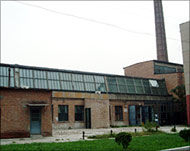Beijing’s art scene makes a comeback
Shanghai may be China’s economic capital, but Beijing residents believe that when it comes to culture, their city has no rival. Yet, art in modern China still has a long way to go.

Beijing’s cultural aficionados are celebrating the city’s first art biennial exhibition. Held from early September to late October, 270 artists from more than 40 countries have their works on display.
“The biennial is a wonderful showcase opportunity for Chinese art, it will allow understanding to increase between East and West,” said a spokeswoman.
Although criticized by some contemporary artists as leaning too heavily towards traditionalist paintings, the exhibition is widely seen as putting Beijing on the global art map.
“It will certainly make Beijing look more international,” said Brian Wallace, owner of local gallery Red Gate.
There is little doubt that Chinese art has come a long way from the late 70s when the cultural revolution, responsible for the destruction of artists and their works, came to an end.
|
|
|
Red Gate gallery: one of many |
Chinese artists now regularly exhibit on an international level with a number of worldwide galleries devoted exclusively to mainland art. Personal artistic creativity and output is now unrestricted, although at a local gallery level, censorship still applies.
“Artists can now paint whatever they want,” said Wallace. “It is at the exhibition stage one has to be careful. Our next exhibitor has some highly graphic works of him and his wife in bed together- he knows we cannot hang those up.”
Early days
But the contemporary art market is still in its early stages. According to Wallace, 99% of all buyers are foreigners.
“People are buying art for aesthetic reasons only; there is currently no second hand market for these works. Most local people, when they come in here, don’t even know they are in a gallery…they certainly don’t know how to appreciate art.”
Lionel Fang is joint owner of the Yan Club, one of only a few Beijing galleries that holds year round exhibitions.
|
“Chinese art is not complete. It is developing from a low level… Not many people are currently willing to buy a painting for their living room.” Lionel Fang |
“Chinese art is not complete. It is developing from a low level. In China, much will depend on how people will accept art and what their financial situation is like. Not many people are currently willing to buy a painting for their living room.”
The Yan Club, together with Lu Jie’s elaborately named gallery- The 25,000 Cultural Transmission Centre- is located in the newly founded bohemian art district Factory 798.
The galleries form part of a vast complex of galleries, shops and bars that are spearheading China’s modern art movement through exhibitions and interactive workshops.
Lu Jie’s latest venture examines Chinese identity through art by retracing the route of the 1934 Long March.
“In a developed country like the US, the education system introduces art to the population but here we need to reach out to the audience directly. If artists totally abandon the public and work only for the international audience then there is a problem.
An event like the biennale creates a market where artists are focused on welcoming international buyers rather than seriously engaging with representing modern Chinese culture,” he said.
Knowing your audience
The problem of reaching out to the public is compounded by the poverty of many artists, and subsequent attraction of trying to create something that has wider appeal, even if that means sacrificing artistic originality and cultural heritage.
“There are only eight or nine original artists in Beijing, the rest copy or are in the process of learning,” says Sheng Qi, a painter and performance artist. The latter is the one genre of art still prohibited by government officials.
Lu Jie says: “Art in China is ahistorical-we play with politics and history, we don’t really examine or engage with it.”
Sheng Qi who, following a June 1989 crackdown, cut off a finger in protest, said: “Most of these artists are not really artists, they do not understand art.”
Budding work
 |
|
Factory 798: Newly founded |
Factory 798, with its still intact Mao Zedong slogans emphasizing Marxist-Leninist thought contrasting sharply with chic fashion shows and futurist sculpture, is seen as a symbol of what contemporary art can become.
The government, long a thorn in the side of anything that had even a hint of controversy, has gradually been realizing this.
“Rather than ignoring galleries and curators as was the case in the past, the government is trying to co-opt us. Now they are interacting with artists hosting these biennials in Shanghai, Guangzhou and now Beijing,” said Wallace. “They have realized that contemporary art is an important part of Chinese culture.”
The result is visible not just in the very public biennial, but in the subtler merge of the traditionalist museums and ministries with the independent galleries.
“The government now talk regularly with us, they include us in discussions on policy decisions affecting the art market,” Wallace added.
The results may not immediately translate into the sort of changes some artists would like to see – improved educational structure, freer licenses to exhibit and perform and market based initiatives such as hosting auctions – but they do suggest a change in the way the government and the public will look at contemporary art.
According to Lu Jie: “We should start this journey. If you don’t start how do you know what is in front of you or behind you? How do you even know what is with you right now?”
